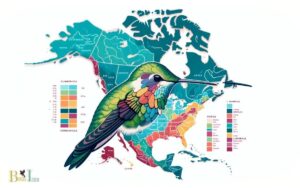When Do Ruby Throated Hummingbirds Lay Eggs? Late April!
Ruby-throated Hummingbirds typically lay eggs from late April to early July, with the timing varying by geographic location.
The breeding season for Ruby-throated Hummingbirds, which is when they lay their eggs, is influenced by several factors, including daylight hours, temperature, and food availability.
These tiny birds migrate north from Central America to North America in the spring to breed. Once they arrive and establish their territory, the female builds a nest and lays her eggs.
Discover the fascinating nesting season of Ruby-throated Hummingbirds, where each delicate egg heralds new life in the lush springtime.

Key Takeaway
Ruby-Throated Hummingbird Breeding Season
The Ruby-throated hummingbird breeding season typically begins in late spring and extends through early summer, during which time they engage in courtship displays and nest building.
As the weather warms and the availability of food increases, male hummingbirds establish territories and begin their elaborate courtship rituals to attract females.
The females, on the other hand, meticulously select nesting sites and construct their tiny cup-shaped nests using plant fibers, downy materials, and spider silk, camouflaging them with lichens and moss.
Throughout this period, the birds are highly active, utilizing their energy to prepare for the upcoming reproductive phase.
Understanding the factors influencing egg-laying timing is crucial in comprehending the intricate breeding behavior of Ruby-throated hummingbirds.
Factors Influencing Egg-Laying Timing
Factors influencing the timing of egg-laying in Ruby-throated hummingbirds are influenced by various environmental and physiological factors.
Environmental Factors:
- Food Availability: The abundance of nectar sources affects the female’s ability to acquire sufficient energy for egg production.
- Weather Conditions: Adverse weather, such as prolonged periods of cold or rain, can delay egg-laying as it impacts the availability of food and nesting conditions.
- Predation Risk: High predation pressure may lead to delayed egg-laying as females prioritize finding safer nesting sites.
These factors play a crucial role in determining the optimal timing for egg-laying in Ruby-throated hummingbirds, ensuring the survival and reproductive success of the species.
Understanding these influences provides valuable insights into the delicate balance of environmental and physiological cues that govern the breeding behaviors of these remarkable birds.
Signs of Impending Egg-Laying
As Ruby-throated hummingbirds prepare for egg-laying, they exhibit distinct behavioral changes, such as increased territoriality and aggression.
Additionally, the female starts to build her nest meticulously, using a combination of plant fibers, downy feathers, and spider silk.
Moreover, she intensifies her foraging activities to ensure she has enough energy to support egg production and incubation.
Behavior Changes Before
Before laying eggs, ruby-throated hummingbirds exhibit distinct behavioral changes that signal the impending egg-laying process.
These changes include:
- Nest Building: Female hummingbirds meticulously build and prepare their nests, often using materials such as spider silk, moss, and lichen, to create a secure environment for their eggs.
- Aggressive Behavior: Both male and female hummingbirds become more territorial and aggressive, defending their nesting sites from other birds and potential threats.
- Increased Feeding: Female hummingbirds intensify their food intake to gather the necessary energy for egg production and incubation.
These behavioral changes are crucial indicators that egg-laying is imminent. Understanding these signs can help bird enthusiasts and researchers anticipate and observe the fascinating process of ruby-throated hummingbird reproduction.
Nest-Building and Foraging
After exhibiting distinct behavioral changes, such as nest-building and increased feeding, female ruby-throated hummingbirds begin to demonstrate signs of impending egg-laying through their meticulous preparations and foraging activities.
Nest construction is a crucial indicator of a female hummingbird’s readiness to lay eggs. The female meticulously weaves together plant fibers, down, and spider silk to construct a small cup-shaped nest, often situated on a slender tree branch or shrub.
Additionally, the female intensifies her foraging efforts, diligently collecting nectar, small insects, and spiders to meet the increased energy demands of egg-laying and incubation.
Observing these behaviors provides valuable insights into the imminent arrival of new hummingbird hatchlings. These preparatory activities are essential steps in the reproductive cycle of the ruby-throated hummingbird.
Nest-Building and Egg Deposition
The Ruby Throated Hummingbird’s nest-building and egg deposition process is a crucial aspect of their reproductive behavior.
- Nest Construction: The female hummingbird meticulously constructs a small cup-shaped nest using plant fibers, moss, and lichens, binding it together with spider silk for added elasticity.
- Location Selection: The nest is often situated on a downward-sloping tree branch, camouflaged with lichen and placed at a height that deters predators.
- Egg Deposition: The female typically lays two pea-sized, white eggs, which she incubates for about 14-16 days.
This delicate process requires precision and care to ensure the survival of the offspring. Understanding the intricate details of nest-building and egg deposition provides insight into the challenges these tiny birds face during the reproductive phase.
Incubation Period and Hatching
During the incubation period, the female Ruby Throated Hummingbird diligently maintains and warms the eggs for approximately 14-16 days before they hatch. This process is crucial for the development of the embryos inside the eggs.
The female hummingbird sits on the eggs, using her body heat to regulate the temperature and ensure consistent warmth, vital for the proper development of the embryos.
During this time, she rarely leaves the nest and relies on nectar and small insects for sustenance. The eggs must remain undisturbed and at a consistent temperature for successful hatching.
As the incubation period nears its end, the female may become more vigilant and attentive as she senses the imminent hatching of the eggs.
This critical period prepares the eggs for the next stage in the life cycle of the Ruby Throated Hummingbird, the parental care and fledging process.
Parental Care and Fledging Process
Upon hatching, the female Ruby Throated Hummingbird assumes the responsibility of providing parental care and overseeing the fledging process for the newly hatched chicks.
- Feeding: The female feeds the chicks a diet consisting of regurgitated nectar and small insects to provide essential nutrients for growth and development.
- Frequency: Feeding occurs approximately every 20 minutes during the day, ensuring the chicks receive adequate nourishment.
- Growth Monitoring: The female carefully monitors the chicks’ growth and adjusts feeding frequencies and amounts as needed to support their development.
- Fledging: As the chicks near the fledging stage, the female encourages them to exercise their wing muscles through short flights within the nest to prepare for their first flight.
This meticulous parental care and oversight of the fledging process are crucial for the survival and successful development of the Ruby Throated Hummingbird chicks.
Conclusion
The timing of egg-laying in Ruby-Throated Hummingbirds is influenced by various factors, including environmental conditions and hormonal changes.
The process of nest-building, egg deposition, incubation, and parental care is crucial for the survival of the offspring.
Despite the delicate nature of this process, the Ruby-Throated Hummingbird’s ability to adapt and thrive in diverse environments is truly remarkable.






